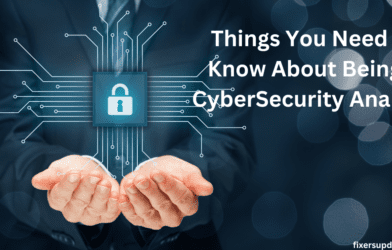Top Cyber security Practices All Business Must Adopt
The threat landscape for business is getting bigger, especially in today’s digital age. As rapidly-evolving threats mimic the abilities of even more sophisticated hacks and accidental data leaks your sensitive customer or internal data are being attacked every day. The practice of strong cybersecurity is no longer a matter of if, but when — it’s a critical tool in protecting the assets and reputation of your organization. Here are the top best practices to make your organization more secure against cyber attacks. With adherence to those, you will fortify your security postures against the possible vulnerabilities and ensure business continues as usual despite any potential threats that may come through. Protect your business as a top priority with cybersecurity
Basic Small Business Cybersecurity Best Practices
In the digital world, cyber security is not only an IT issue but is a more serious business threat. And since cyber threats are on the rise, businesses of all sizes need to be implementing systems security best practices to keep their assets, data and reputation safe. This guide lists down basic cybersecurity best practices that all businesses must comply with.
Importance of Cybersecurity for Businesses
Data leaks, reputational harm and financial damage are just a few of the potentially devastating consequences tied to cyberattacks. A successful cyberattack, depending on the severity, can have devastating effects including:The following used to be included in previous sections without first explaining why they could happen.
Loss of customer sensitive data
Financial fraud and theft
Disruption of operations
Catastrophic blow to your brand reputation
Penalties for breaking rules
With businesses increasingly relying on technology and remote work arrangements, the importance of cybersecurity has never been higher.
Some of the common cybersecurity best practices for businesses include :
To provide additional protection for your organisation against cyber threats, you can leverage the following best-practices:
Strong Passwords and 2-Factor Authentication
In the digital era our first defense line against spyware and other cyber threats is a strong password. Mandate a company-wide standard for complex passwords including upper and lower case letters, numbers and special characters Recommend using password managers to generate and maintain unique passwords for each account.
Adapt Multi-Factor Authentication
Multi-factor authentication (MFA) across all company systems/applications MFA offers an additional layer of protection whereby users have to provide 2 out of the three credential factors to gain access. This could be something they know (password), something they have (smartphone) or something they are (biometric data).
Establish Security Training and Awareness Programs
Empowering your employees is Your first-line of defense against cyber threats. Develop well-rounded security training for employees that includes topics like password hygiene, phishing awareness, and safe browsing habits. Pointers and guidelines aside, regular workshops and simulated phishing exercises would help reinforce these teachings at the back of your employees minds.
Build aSecurity-First Culture
Prompt employees to report in case of unusual activities Develop a “Where Security is Everyone’s Job” culture, not just the I.T folks. Incentivize those who use good security practice, and create a culture of both vigilance and proactive protection against cyber threats.
Do not forget that your employees are your greatest resource…. and sometimes liability! Arm them with the information and technology to be your best cyber defense.
Back Up Your Data Regularly
Data is the lifeblood of your business these days in a digital landscape. Backups are your insurance plan for when shit hits the fan. The next important one is to have a feasible backup strategy that involves on-site and off-site backup solutions. Using Cloud based Services Have Some Security and Accessibility Benefits
Frequency Matters
Critical data should have automated daily backups and less crucial stuff a weekly backup. The most popular interest here — hosts are not allowed access to downloaded data, which minimizes the risk of loss in case of any cyber-incident.
Test Your Backups
Don’t just back up—verify. Conduct regular testing of your backup systems to make sure they are working correctly and data can be restored successfully. This way you save yourself from bad surprise being struck while experiencing an actual crisis.
Update Apps and Devices
Keeping your software and devices current is also an important part of your cybersecurity plan. Updates offer patches to vulnerabilities, bug fixes, and new security features that mitigate a newly discovered threat landscape.
Implement an Update Schedule
Compile a schedule for updating every system, operating systems, applications and firmware. To make sure updates are live on time, try to automate them. In the case of second order bugs that still have a potential to disrupt your system, test updates in a controlled environment before delivering the full update.
Monitor End-of-Life Products
Track software and hardware EOL. Manufactures tend to discontinue support for old devices and don’t update the firmware, which means that the old ones will be exposed to new security breaches. When to replace or upgrade parts in a timely manner so you can stay ahead of the next evolving cyber threat with ease and keep your business secure.
Use Encryption and Firewalls
It is necessary to have strong encryption and firewall systems in place to protect your digital assets as a business. Encryption — which converts data into unreadable code—also reduces the probability of unauthorized access. Use end-to-end encryption for all transmissions, especially when confidential information is in the field.
Firewall — Firewalls are a barrier between your internal network and external threats. Use firewalls to track traffic coming into and leaving the system, thus block any unauthorized activities. Use next-generation firewalls that come with regular intrusion detection and application-level filtering capabilities
Encrypt Your Data: Always keep your encryption protocols and firewall rules up to date to protect yourself from new-age cyber threats. And when you put them all together, a very strong defense against would-be breaches ensuring that your business data stays safe and unseen.
Use Firewalls and Anti-Malware
Defending your company from online cyber threats demands creating strong digital fortifications. Firewalls work as a barrier, and it is the first line of defence, checking incoming or outgoing network traffic based on set security rules. In essence they serve as a type of gate keeper that sits between your internal network and the external networks i.e. the internet which is untrusted.
Complementing Firewalls
So the Malware/Irritant softwares you need Anti-Malware software to Find,Prevent and Clean it. Including viruses, spyware, ransomware and other malicious scripts that could jeopardise your systems and data.
To maximize protection:
Deploy firewalls to all devices and network access points
Maintain up-to-date firewall rules
Enterprise anti-malware solutions
Configure automatic updates and real-time scanning
Types of Security Training for Employees
Protecting your workforce is the first line of defense from cyber threats. Having a comprehensive security awareness training program is necessary to properly secure your business. Train employees to identify phishing, how to make strong passwords, and keep sensitive information securely. Regular workshops and phishing simulations can harden these chops.
Nurture a Security-Minded Culture.
Train your employees to sing and appreciate suspicious behaviour. Establish Legible Security Policies Encourage a security-conscious mindset among all as opposed to focusing on the IT department.
Get Massive Threat Intelligence Solution.
Cyber threats evolve rapidly. Create newsletters or webinars that can be sent to your team on a weekly basis or have monthly meeting where you update your team in regards to all latest security risks and countermeasures. This proactive philosophy helps to keep you secure.
Enforce MFA (Multi-Factor Authentication)
MFA (multi-factor authentication) is key for cyber security as it adds an additional layer of protection to your business accounts. As of now, if the password is compromised there are still other authentication factors users need to provide to access secured information and files, thus greatly preventing unauthorized penetration.
Implement MFA
Enable MFA on all critical systems (email, cloud services, financial platforms). These usually consist of: something you know (e.g. password), or something you have (e.g. smartphone app, hardware token) or even something you are (biometric data).
This might be seen as a minor annoyance however in regards to security, the slightest disruption is worth protecting your site. When implemented properly, MFA can stop up to 99.9% of automated attacks; this makes it a must-have in the security toolbelt.
Offer Security Awareness Training
Informing your employees and leading them into the ways of cybersecurity is one of the keys to protection from cyber threats.business. Regular security awareness training creates a human firewall against cyber threats. Take action by teaching your staff about such attack vectors as phishing, social engineering and how to protect their password. Practice with simulated phishing (knowledge reinforcement and testing) Topics include safer browsingAcquiring more resources to dive further into a particular topic, best practices in handling sensitive information and identifying suspicious behaviors.
Ongoing Education
Incorporate training into an ongoing process rather than a single event. Inform your team of new vulnerabilities and changes to the industry. Nurture a culture where security comes first, and where employees can report what they suspect are incidents without fear of repercussions. This is your first line of defense against cyber attacks, remember it!
Back Up Critical Data
When it comes to today’s digital world, failing to backup your business critical data is no longer an option Backups are like a safety net to protect you against data loss, cyberattacks and system failure. Use a stringent backup mechanism comprising of;
Daily incremental backups
Weekly full backups
Offsite & Cloud Storage Solutions
Protect your backups as well by encryption. Verify that you are able to access and retrieve the data when it counts most (i.e. testing your restore process) And further, A backup is only as good as it can be restored. When you backup your data, you are prioritizing the most important aspect of your business: the information.
VPN (Virtual Private Network)
For your employees who work remotely, a VPN is very important when it comes to making their internet connection secure. A VPN ensures that data transferred between remote devices and your corporate network is encrypted, preventing valuable information from being intercepted.
13. Stop Theft[%divide]%Physical
However, cyberthreats are only a small part of the story when it comes to cybersecurity. Use physical security to protect your devices and data Examples would be keeping devices locked away when not in use, using cable locks for laptops, and making sure employees store their electronics securely.
14. Secure Mobile Devices
With mobile devices now increasingly working in conjunction with ‘business as usual’, security becomes an essential aspect that needs to be dealt with. Mandatory for the employees to enable password protection, install security apps and report any lost or stolen devices at the earliest.
15. Assess Third-Party Security
Assess the security protocols for third-party vendors & partners that interact with your systems. Make sure that they respect the same security procedures to avoid side effects over shared execution.
Selecting a Cybersecurity Vendor
It may not be a core competency for many businesses. There are a few key things to look at when deciding on a cybersecurity provider.
Trust & Reviews – Find some unbiased reviews and case studies to know how good the services are?
End-to-End Approach: Select a provider who can provide solutions in addition to detection and response.
Scalability: As your company grows and changes needs, the cyber security solutions need to grow with it.
Conclusion
As a business owner of the 21st century, you are under just as many threats in the cyber world as any other high value target and your ability to keep using the internet will depend on how well prepared you are for these threats. Please note that following what is given in this article may only help minimize the risk and that falls on your organisation to be a victim to cyberattacks. Third, just to remind you: cybersecurity is an ongoing effort that requires constant vigilance and adjustment. Keep educating yourself about the threats, always keep your systems and policies up to date and promote security instead of comfort among your employees. Advanced cyber threats will always wage war on the digital world, but by being proactive and implementing the above strategies, you can safeguard your invaluable assets, keep customer confidence intact and prepare your business for long-term survivability against emerging predictors.
1. What are the best practices of cybersecurity?
These are just a few best practices for OT cybersecurity — keeping software up to date, using strong passwords, employing MFA and training employees in how to recognize phishing attempts are among the most prominent. Moreover, companies must carry out regular security audits and use encryption to safeguard their confidential information.
2. What are the 5 best methods used for cybersecurity?
Best methods are firewalls (also more broadly for security also), encryption, intrusion detection systems, commonplace applications security updates and strong access controls. They safeguard networks, data and systems from unauthorized access as well as cyber threats.
What is a cybersecurity strategy for a business?
A cybersecurity strategy is a map of everything your business intends to do to safeguard its data and IT infrastructure. This can be comprised usually of threat detection, data protection, risk management, incident response record and training the employees to adhere to security practices.
4. How to improve business cybersecurity?
Companies that follow strong access controls, make system updates, use encrypting techniques and conduct regular evaluations of their security are able to enhance cybersecurity. Regular training of employees to identify threat like phishing is essential for a safe environment.














